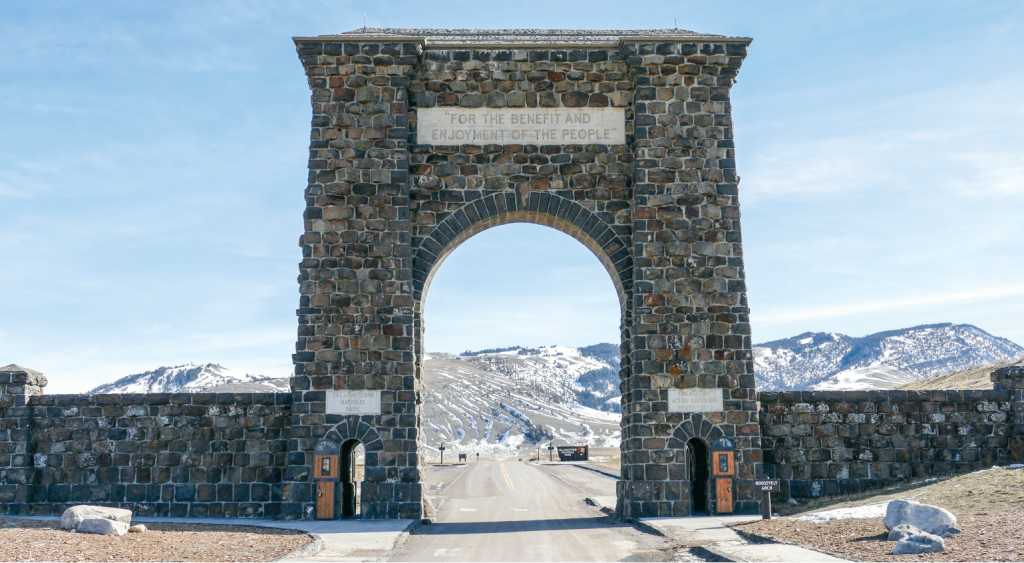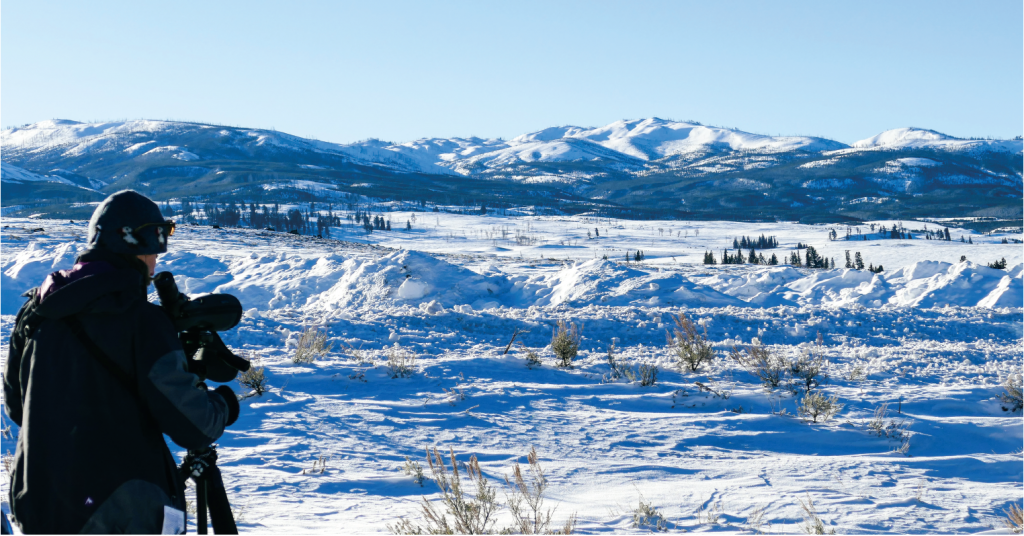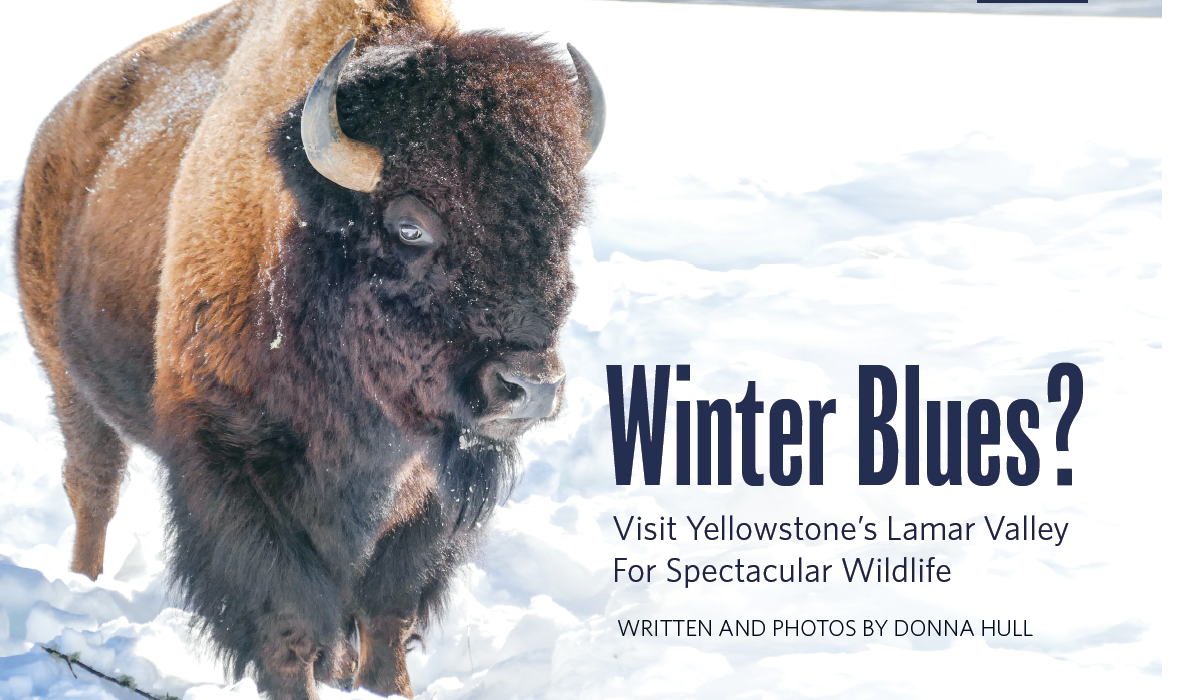For years, I’ve wanted to visit Lamar Valley in the winter, especially to see wolves. Located in the remote northeast corner of Yellowstone National Park, the Lamar Valley is America’s version of the Serengeti. Or so
I’ve read. And Montana Highway 212, the only road that’s open to vehicular traffic during Yellowstone’s winter season, just happens to travel through the valley.
After obsessively watching weather forecasts during a particularly stormy winter season in the Bitterroot Valley, my husband Alan and I finally saw a window of opportunity in mid-February. Road reports were good, there was little snow forecasted and Yellowstone National Park’s brutal winter temperatures have moderated to above 0 F. It was time to roll.
We’re lucky that Gardiner, Montana, northern gateway to Yellowstone National Park, is only a five-hour drive from our home — a little more if we take the scenic route through the Big Hole Valley, which of course we do.
If you’re flying to Montana to visit the Lamar Valley, fly into Bozeman, then rent a four-wheel-drive car for your adventure.
Where to stay on a Lamar Valley winter visit If you’re looking for Lamar Valley lodging, I’m sorry to tell you there isn’t any. So, Alan and I made Gardiner, Montana, our headquarters for this brief Yellowstone winter vacation.
We arrived in Gardiner in the late afternoon for a one-night stay at the Best Western Plus Mammoth Hot Springs. We spent the next day exploring the Lamar Valley before driving to Grey Cliffs Lodge for a romantic Valentine’s Day getaway. Next time, we’d like to try the newest luxury property in the area, Sage Lodge in Pray, Montana. Yellowstone National Park lodging at Mammoth Hot Springs Hotel & Cabins would have been our preferred choice, but the hotel has been closed for renovations during the past three winter seasons.
If you’re planning a visit to Gardiner in the winter, it’s a good idea to confirm reservations before arriving. Several restaurants and hotels are closed for the season. We found dinner at the Yellowstone Mine Restaurant located next door to the hotel.

The next morning, we fueled up at the free hot buffet there provided by Best Western. And then it was a short drive through Gardiner to the park.
Driving through Yellowstone in the winter If you’ve ever wondered about driving in Yellowstone in the winter, the simple answer is yes, you can. But the more complicated reply is, you can only drive through the Montana portion of the park from Gardiner to Cooke City. Otherwise, Yellowstone National Park winter access is off limits to vehicular traffic.
But you can book Yellowstone National Park winter tours for access to other parts of Yellowstone. Choices abound, from cross-country skiing, snowmobiling, wildlife watching to touring the geysers as they spray a frosty shimmer over the landscape. The Yellowstone Old Faithful Snowcoach Tour is a popular option.
Watching for wildlife
After driving through the iconic Teddy Roosevelt Arch, it’s as if Yellowstone is trying to prove to us that it is indeed America’s Serengeti. We had not even entered through the park’s guard gate and already large numbers of buffalo, elk and pronghorns were visible as they grazed on the hillside
below Electric Peak.
After a friendly chat with the park ranger, we were on our way up the road to Mammoth Hot Springs. Since we only had one day to visit Lamar Valley, Alan and I agreed that this trip was a reconnaissance mission for future adventures. We drove to Cooke City for lunch, taking it slowly and stopping at all the turnoffs, before retracing the drive back to Gardiner. We had to save any snowshoeing, winter hiking or prolonged wildlife watching for another time. Unfortunately, this also meant a walk on the boardwalk of the Mammoth Hot Springs Terraces had to wait for our next visit.
Driving Grand Loop Road to Tower-Rosevelt
At Mammoth Hot Springs, Grand Loop Road, Highway 212, turns east. Although there’s lots of snow on the ground, the road is mostly in good shape. Because this is the only winter road access for Cooke City citizens, plows clear the road during daylight hours.
There’s plenty to see along the road before reaching Lamar Valley. The pavement climbs and weaves its way through the Gallatin Range with views of the Yellowstone River to the north and Blacktail Deer Plateau to the south. Bison are everywhere, including along the road, so it pays to adhere to Yellowstone’s 35-mile-per-hour speed limit.
When we see groups of wildlife watchers set up with scopes in a turnout, we always pull in, if there’s room to park. Although spotters have the reputation for being friendly, we don’t find that to be the case.
The plowing for Grand Loop Road ends at Tower-Roosevelt. In the summer, the road loops around to Tower Fall, Grand Canyon of the Yellowstone, Norris and back to Mammoth Hot Springs.

Following Highway 212 into the Lamar Valley
Our route continues east to the Northeast Entrance Road, Highway 212. After Slough Creek, Lamar Valley opens up in a large U-shape, thanks to the carving action of ancient glaciers. This is the heart of America’s Serengeti and the beginning of our self-guided Lamar Valley wildlife tour. It’s a wildlife watcher’s heaven!
A couple of cars stopped in front of us to watch big horn sheep on a rocky hillside. After maneuvering past them, Alan stopped at the closest pullout, and then we walked back to photograph the sheep. Park guidelines request that visitors do not stop their vehicles in the road. Where the road hugs Soda Butte Creek, we came across another pullout with cars. Three buffalo struggling through deep snow had attracted photographers and wildlife watchers.
Don’t startle wildlife by talking loudly or slamming car doors. Remember you are a visitor in their habitat.
Taking a coffee break in Cooke City
The road climbs again as it leaves the Lamar Valley and Yellowstone National Park. After Cooke City, Highway 212 becomes the Beartooth Highway, one of America’s most scenic drives. But in the winter, plowing stops at Cooke City meaning the only access to the outside world for town residents is the journey back through Yellowstone National Park to Gardiner.
Although we had planned to stop for lunch, the drive to Cooke City had gone quicker than expected. So, we enjoyed a cup of coffee and mid-morning snack while watching snowmobiles buzz up and down the street.
Miles of trails make Cooke City a prime snowmobiling destination. Now we’re tempted to return for a guided snowmobile tour. There are plenty of vacation rentals available. Wouldn’t that be a fun week in the Montana snow? Avoid a winter drive to Lamar Valley on Friday, Saturday or Sunday when cars and trucks pulling snowmobiles are traveling to and from Cooke City for a weekend of fun.
Waiting at a bison traffic jam
The views were just as stunning on our return back through the remote northeastern corner of Yellowstone National Park. Although we didn’t see any wolves — you really need to stake out a spot and stay in one place to see wolves — we lost count of the number of bison that crossed the road in front of us. To really spot wolves, I recommend booking a Lamar Valley wolf watching tour.
After about two hours of driving, we’re back at Gardiner. There’s just enough time to drive on to Grey Cliffs for our gourmet dinner and three-night Valentine’s getaway. But the northeastern corner of Yellowstone — and Cooke City — is calling our names. We’ll definitely return for another Boomer travel adventure.
Lamar Valley winter travel tips
Traveling to the Lamar Valley in the winter requires planning ahead. Here are some websites and tips to help you prepare for a cold weather trip: Keep track of Montana road conditions with the Montana Department of Transportation. Monitor the weather through the National Weather Service. To get more specific, use the Gardiner, Montana zipcode: 59030. Check park road conditions, weather and travel alerts at the official Yellowstone National Park website.
Don’t let cold weather discourage you from traveling to Yellowstone National Park. Which winter month is best for visiting Yellowstone? January tends to be brutally cold with winter temperatures moderating a bit in mid-February to mid-March. You won’t be disappointed with the views and wildlife during the winter months.


